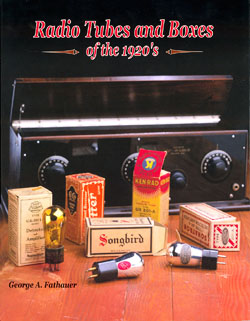Of Old Radios And Related Items--Published Monthly
Radio Tubes and Boxes of the 1920's
By George A. Fathauer
REVIEWED BY DICK BERGERON
Web edition
Numerous tube manuals and books have been published over the years. The most notable were the "Spec and Data Sheets" released by tube manufacturers at regular intervals as new tubes were released. As time marched on and the interest and use of the electron tube waned due to technological advances, publications on tubes also dwindled in number. The contents of tube books still being published became more selective, shifting from technical data to a more general chronological and historical roadmap of the evolution of tubes from the early 1920s into the 1970s and 1980s.This selective process continues with the release of Radio Tubes and Boxes of the 1920's by George A. Fathauer. As the title suggests, the book pictorially displays the tubes used in early broadcast receivers of the 1920s. As an additional bonus, pictures of the unique tube boxes that these tubes were sold in are also portrayed. A historic overview to the period is contained in the introduction, while an updated list of 201-A brand names and a selected bibliography are also included.
Thumbing through the pages of this book, one can't help but notice the hundreds of different companies that released or produced the 01-A tube. As the author mentions in his introduction, RCA owned the patent rights to this tube. Some companies selling the tube were "legal," while others were not.
Radio Tubes and Boxes of the 1920's
When the going was good, the companies trying to peddle this tube had to implement a few of the key marketing techniques known to be effective in selling a product successfully. Those tricks of the trade were 1) price -- sell it cheaper than the other guy -- or 2) unique packaging -- the tube box filled this bill.Packaging truly was dominant. The names of companies like Apex, ACE, Advance, Blue Ribbon, and Champion on boxes suggested that the product was the best of breed. Or how about Boone, Crusader, and Pioneer as indicators of leaders in the industry? A box labeled Perfectone, Tru Tone, Music Master, Kleer-Tone, Fultone, or Grandtone needed no further explanation about its contents. At the bottom end of the spectrum, company names like PAR, OK, and Quality might suggest cheaper, run-of-the-mill products.
All in all, the color photos of the tube boxes are particularly interesting. In their imaginative methodology of packaging, these companies related their names to the quality of their products. If you are collecting old tubes in boxes, this book is a "must have."
Radio Tubes and Boxes of the 1920's by George A. Fathauer is a soft covered and has 105 pages with over 400 color photos and illustrations. The book is available from Antique Radio Classified, P.O. Box 1558, Port Washington, NY 11050. (516) 883-0505. E-mail: arc@antiqueradio.com or go to our web site at www.antiqueradio.com.
(Dick Bergeron, Box 8311, Essex, VT 05451)
Dick Bergeron is the propietor of Electron Tube Enterprises, which can be reached at the above address or by telephone at (802) 879-1844 or fax at (802) 879-7764. His latest catalog lists over 2000 types of radio, TV, transmitting, military, communications, industrial, etc. tubes in stock. All tubes are new-old- stock. Since new tubes are being added to stock continually, collectors should inquire when the tube they are looking for is not listed.
| [Books, DVD's, For Sale] [Subscribe to A.R.C./Renew] [Auction Prices] [Event Calendar] [Links] [Home] [Issue Archives] [Book Reviews] [Subscription Information] [A.R.C. FAQ]
For Customer Assistance please contact arc@antiqueradio.com or call 516-883-0505
Antique Radio Classified |
